
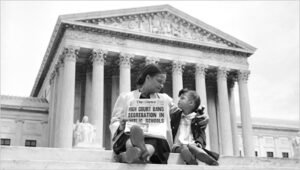
This year is the 70th anniversary of Brown v. Board of Education, arguably the Supreme Court’s most iconic decision. The American Journal of Law and Equality is publishing a symposium on the topic, and I am one of the participants. A draft of my contribution, entitled “Brown, Democracy, and Foot Voting,” is now available on SSRN. Here is the abstract:
Traditional assessments of Brown‘s relationship to democracy and popular control of government should be augmented by considering the ways it enhanced citizens’ ability to “vote with their feet” as well as at the ballot box. Brown played a valuable role in reinforcing foot voting, and this has important implications for our understanding of the decision and its legacy.
Part I of the article summarizes the relationship between foot voting and ballot box voting, and how the former has important advantages over the latter as a mechanism of political choice. Relative to ballot box voting, foot voting offers individuals and families greater opportunities to make decisive, well-informed choices. It also has special advantages for minority groups, including Blacks.
Part II considers traditional attempts to reconcile Brown and democracy, through arguments that the decision was actually “representation-reinforcing.” While each has its merits, they also have significant limitations. Among other flaws, they often do not apply well to the Brown case itself, which famously originated in a challenge to segregation in Topeka, Kansas, a state in which – unlike most of the South – Blacks had long had the right to vote.
Part III explains how expanding our understanding of Brown to include foot voting opportunities plugs the major holes in traditional efforts to reconcile the decision and democratic choice. Among other advantages, the foot-voting rationale for Brown applies regardless of whether racial minorities have voting rights, regardless of whether segregation laws are motivated by benign or malevolent motives, and regardless of whether the targeted ethnic or racial groups can form political coalitions with others, or not.
In Part IV, I discuss the implications of the foot-voting justification of Brown for judicial review of other policies that inhibit foot voting, particularly in cases where those policies have a history of illicit racial motivations. The most significant of these is exclusionary zoning.
As noted in the article, producing a thesis on Brown that is both new and useful is a tall order. Few if any other judicial decisions have been analyzed so much. But, as the saying goes, “fools rush in where the wise fear to tread.” And so I accepted the journal’s invitation.
I welcome comments, suggestions, and criticisms.
The post New Article on "Brown, Democracy, and Foot Voting" appeared first on Reason.com.
]]>
Big Brother—and Parent, and Teacher—are watching.
Across America, teachers are uploading students’ grades to digital portals on a weekly, daily, or sometimes hourly basis. They are posting not just grades on big tests, but quizzes, homework, and in-class work too. Sometimes teachers give points for day-to-day behavior in real time: Did he raise his hand before asking his question? No? Points are docked. Parents are notified. So are the kids.
The pupil panopticon starts in elementary school and just doesn’t stop.
In one high school, I am told, the grading portal changes color when the grade, even on a single assignment, pushes the kid’s average up (green) or down (red). This can fluctuate by the hour, which means so can a kid’s feelings of joy or despair. Parents can enjoy the same stomach-churning experience because they, too, have access to the portals, for better or worse.
“If I have to hear one more time from my wife about how our son isn’t going to college because he forgot to hand in a single homework assignment or did bad on ONE test I’m gonna fucking lose my mind!” is how one father expressed it on Reddit. “All it does is annoy the shit out of him, annoy the shit out of me, and damage his relationship with her. That’s it.”
That really is it. Even many of the parents who say the portal helps them keep their kids on track still admit it’s a source of stress. They get an extra helping of angst when they watch their kids nervously await the exposure of their grades.
This new school-to-parent pipeline allows parents to micromanage yet another aspect of their kids’ lives. They already track their kids’ locations, via devices and AirTags. And of course, they sign the kids up for organized activities, so the kids are always doing something adult-supervised and parent-approved. Now they have become an invisible presence in one place they used to be banished: the classroom. The message for parents is they should always be watching their kids, even as their kids grow up under a microscope, telescope, and periscope.
I asked for comments on the portals via Facebook. Many people who responded asked me not to use their full names because they’re upset about the system but don’t want their kids to suffer extra for their indiscretion. “My son has ADHD and minor anxiety and he is obsessed with the grade portal—he’s 11,” wrote Jen, a mom in Marshall, Texas. “When he’s waiting for a quiz or test grade, he’s constantly trying to check and refresh the page. It’s disturbing.”
Beth Tubbs is a therapist in the Pacific Northwest who sees a lot of young people with anxiety. She says these portals aren’t helping. When grades are available to students and their parents in real time, “Everything feels high stakes,” Tubbs says. She’s had tweens tell her, “I’m really anxious because I got a C on my geometry test and that means I’m not going to get into a good college.”
Since a lot of parents are just as anxious, the ever-present portals can create a feedback loop. The parents worry that if they aren’t on top of things, their child might not be successful. So they’re always checking the portal, which makes the child worry that any bad grade means the end. Repeat this day after day, and it starts to feel as if grade portals may be one unexamined reason kids’ anxiety is spiking.
It’s not just the high school juniors and seniors who are suffering. ClassDojo is a popular portal that allows teachers to grant and dock academic and behavior points starting with kids as young as age 5.
“Depending on the teacher’s updating habits, you may get pinged with updates throughout the day on how well your child is sharing, sitting crisscross applesauce, staying quiet when directed, and following other classroom expectations,” writes Devorah Heitner in her new book, Growing Up in Public.
The result can mean no let-up for the parent or the kid.
“Three weeks into my son’s kindergarten year, I’m already dreading any notification from this app,” a mom named Melissa wrote on an education blog about the app. “The only thing I hear are private messages about what he’s done wrong. My workday is spent dreading the notification from this horrible application, and I feel so defeated about school already. I can only imagine what my son’s feeling.”
The set-up is even making teachers anxious. One told me she accidentally gave a student a low grade on a quiz because of a typo. Within two minutes, the visibly upset student was asking about the quiz and had already been grounded by their mother. “The online Gradebook has had a….questionable.…impact for some students, parents, and teachers,” the teacher wrote.
The problem is that the portals have created a whole new student/teacher/parent equation, says Emily Cherkin, author of The Screentime Solution: A Judgment-Free Guide to Becoming a Tech-Intentional Family. Before she became “The Screentime Consultant,” Cherkin was a teacher from 2003–2015—that is, both before and after the advent of the portals. When they were introduced in about 2005, she says, she witnessed two things: Her students stopped asking her why they got something wrong on the test, and the parents started asking for them. The portals “triangulated something that shouldn’t have been triangulated,” Cherkin says.
Gone is the opportunity kids once had to daydream in class, or blow a quiz, or crack a joke. As for the parents, they’re almost forced into helicoptering—a fact some are starting to resent.
Melinda Wenner Moyer, author of How to Raise Kids Who Aren’t Assholes and mom of a seventh-grader in upstate New York, says, “I saw my son got a 30 and I brought it up casually like, ‘What happened with that social studies thing?’ And he said, ‘Mom, I’ve got it handled. It was a mistake and I’ve talked to the teacher about it, and I see PowerSchool [the portal] too. I’m on top of it and would appreciate it if you would trust me.'” Since then, says Moyer, she has made a concerted effort not to open the portal much, “and it really helped my relationship with my son.”
Autonomy is one of the three great needs in any human’s life (along with relatedness and competence). Giving kids some autonomy back could be enormously beneficial for both generations, which is why it’s time to seriously consider whether the portals are doing what they’re supposed to do: help students succeed.
Roseanne Eckert is a defense attorney in Orlando. Her son graduated high school in 2017. For a while, she writes, “I would check his grades at work and come home mad, while he didn’t even know the grade yet. I finally decided to stop it and we were all happier. The schools push the parents to be on top of the grades but it is a constant misery. Just say no!” For the record, Eckert adds: Her son was not a straight-A student in high school, but now he’s about to get his master’s degree in biomedical engineering.
So for anyone seeing a B- on that portal: Shut it down, take a deep breath, and wait a few minutes.
Or better still, years.
The post Do Schools Really Need To Give Parents Live Updates on Students' Performance? appeared first on Reason.com.
]]>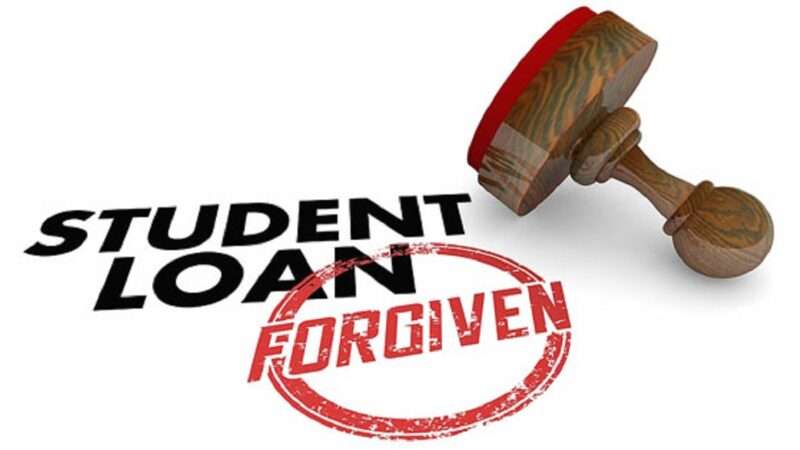

Yesterday, a coalition of eleven red states led by the state of Kansas filed a lawsuit challenging the legality of President Biden’s new loan forgiveness plan, which would forgive at least $156 billion in federal student loan debt. I suspect I am not the only observer who had a strong sense of de ja vu, when they saw this filing. Kansas v. Biden has many obvious similarities to Biden v. Nebraska, the case in which the Supreme Court invalidated the administration’s previous massive student loan forgiveness plan (which would have discharged some $430 billion in student debt). Both involve efforts to forgive large amounts of student debt by exploiting vaguely worded statutes. Both plans are vulnerable under the “major questions doctrine,” which requires Congress to “speak clearly” when authorizing an executive branch agency to make “decisions of vast economic and political significance.” And both cases involve similar procedural “standing” questions.
Because I believe the Supreme Court was right to rule against the administration in Biden v. Nebraska, I think courts should also rule against it here, too. There may be ways to distinguish the two cases. But, so far, it looks like it’s going to be an uphill battle for the administration.
The biggest potential difference between the cases is that Biden v. Nebraska involved an effort to forgive debt under the 2003 HEROES Act, while the current plan relies on the Higher Education Act of 1965 (HEA), as amended. When the previous case was being litigated, some suggested the Administration should rely on Section 432a of the HEA instead of or in addition to the HEROES Act. Section 432a gives the Secretary of Education the power to “enforce, pay, compromise, waive, or release any right, title, claim, lien, or demand” related to federally backed student loans. I critiqued this theory here.
In the aftermath of the Supreme Court’s decision last June, the Biden administration announced they were indeed going to try to put together a new loan forgiveness plan using the HEA. But instead of relying on Section 432a, the administration adopted a rule that relies on Section 455 (codified as 20 U.S.C. Section 1087e), which gives the Department of Education the power to establish “Income contingent repayment schedules” that “shall require payments that vary in relation to the appropriate portion of the annual income of the borrower (and the borrower’s spouse, if applicable) as determined by the Secretary [of Education].” The administration claims this provision gives it the power to adopt repayment plans that essentially forgive at least $156 million in student debt. As the plaintiff states’ complaint summarizes it, the rule “(1) defines “discretionary income” to be income above 225% of the applicable Federal poverty guideline, (2) sets the monthly payment amount at $0 if the borrower’s income falls below that threshold, (3) caps the monthly payment amount at 5% of the borrower’s income that goes above that threshold for undergraduate loans, and (4) cancels all loans where the original principal balance was $12,000 or less after the borrower has made 120 monthly payments or the equivalent.”
The administration claims all this comes within the power to create “income contingent repayment schedules.” But this power is not broad enough to permit massive loan forgiveness, as opposed to merely offering some flexibility in the timing of repayment, based on income. As the states rightly point out, the administration’s theory of Section 455 would allow it to use this power to forgive virtually all federally backed student debt: “there is nothing in the Secretary’s interpretation of the HEA that would prevent him from limiting debt repayment on income-driven repayment plans to 1% of income over $1,000,000 for 1 year only, with all remaining debt—typically 100%—cancelled by the federal government.”
At the very least, it is far from clear that Section 455 gives the Department of Education such vast authority. And if it is not clear whether Congress has delegated such a sweeping power, then the agency’s claim to authority must be rejected under the major questions doctrine, as it was in Biden v. Nebraska. In that case, the Court ruled that forgiving $430 billion in student debt qualifies as an issue of “vast” economic and political significance. The same is true of the current plan.
To be sure, $156 billion is a smaller amount than $430 billion., But as the states point out, the former figure almost certainly underestimates the true cost of the new plan, because it was calculated under the assumption that the Administration’s HEROES Act plan would be upheld by the courts and implemented, thereby forgiving a large part of the debt that might otherwise be covered by the new HEA plan. Since the Administration lost Biden v. Nebraska, the HEROES Act plan was not implemented, and therefore the new HEA plan would likely cover a lot more debt than is included in the figure of $156 billion.
The boundary between major and minor issues under the major questions doctrine is admittedly a fuzzy one. But hundreds of billions of dollars in loan cancellation strikes me as major by any plausible standard. The scope of this plan is at least in the same general ballpark as that of the one struck down in Biden v. Nebraska.
A big issue in Biden v. Nebraska was whether anyone had standing to sue to challenge the plan. Most observers thought standing was the administration’s best chance of winning the case, because it could be none of the plaintiffs challenging the plan had suffered the requisite “injury” required to get standing. Ultimately, the coalition of state governments challenging the plan got standing because one of them (Missouri) had a state agency (MOHELA) that services federally backed student loans, and the agency’s income would be reduced if some of those loans were forgiven.
The plaintiff states in the present case have a similar standing argument. One of them (Louisiana) also has a state agency that services federal student loans and provides student loans of its own. The plaintiffs claim that it—like MOHELA—would lose income if some of those loans (or parts of them) were forgiven.
I have not studied the Louisiana agency (which though the complaint does not name it, is probably the Louisiana Office of Student Financial Assistance) in detail. Perhaps there are differences between it and MOHELA that I have overlooked (e.g.—may be they don’t service as many federal loans, and instead mainly focus on providing their own loans; the latter could still be a path to standing if demand for state student loans goes down as a result of federal student loan forgiveness). But if LOSFA and MOHELA are relevantly similar, Louisiana can get standing in this case much the same way that Missouri got it in the other one.
As this case goes on, we will like learn more about LOSFA, how it works, and its connections to federal student loans. For now, I welcome correction on the subject by people who know more about Louisiana’s student loan system than I do.
The plaintiff states in this case (like the ones in Biden v. Nebraska) also have several other standing theories. I think some of them deserve to prevail, as well. But all are at least somewhat more questionable than the MOHELA/LOSFA theory, an approach already validated by the Supreme Court.
As with the earlier plan, courts would do well to strike down this one because it is dangerous to allow the executive to raid the treasury to use it for purposes not authorized by Congress. For those keeping track, I also, for similar reasons, opposed Donald Trump’s attempt to divert military funds to build his border wall.
While it is not directly relevant to the merits of the case, I should note that the new suit is being spearheaded by Kansas Attorney General Kris Kobach. He is a highly dubious figure that has been sanctioned by federal courts for various types of misconduct, on multiple occasions. I certainly understand if some people view any lawsuit led by Kobach with a healthy measure of suspicion. I am no fan of Kobach myself.
But bad people sometimes bring meritorious lawsuits. This appears to be just such a case.
The post Red States File Lawsuit Challenging New Biden Student Loan Forgiveness Plan appeared first on Reason.com.
]]>
America is celebrated for its economic dynamism and ample and generously paid employment opportunities. It’s a nation that attracts immigrants from around the world. Yet Americans are bummed, and have been for a while. They believe that life was better 40 years ago. And maybe it was on some fronts, but not economically.
Surveys repeatedly demonstrate that Americans view today’s economy in a negative light. Seventy-six percent believe the country is going in the wrong direction. Some polls even show that young people believe they’ll be denied the American dream. Now, that might turn out to be true if Congress continues spending like drunken sailors. But it certainly isn’t true based on a look back in time. By nearly all economic measures, we’re doing much better today than we were in the 1970s and 1980s—a time most nostalgic people revere as a great era.
In a recent article, economist Jeremy Horpedahl looked at generational wealth (all assets minus all debt) and how today’s young people are faring compared to previous generations. His findings are surprising. After all the talk about how Millennials are the poorest or unluckiest generation yet, Horpedahl’s data show them with dramatically more wealth than Gen Xers had at the same age. And this wealth continues to grow.
What about income? A new paper by the American Enterprise Institute’s Kevin Corinth and Federal Reserve Board’s Jeff Larrimore looks at income levels by generation in a variety of ways. They find that each of the past four generations had higher inflation-adjusted incomes than did the previous generation. Further, they find that this trend doesn’t seem to be driven by women entering the workforce.
That last part matters because if you listen to progressives and New Right conservatives, you might get a different story: that today’s higher incomes are only due to the fact that both parents must now work in order for a family to afford a middle-class lifestyle. They claim that supporting a family of four on one income, like many people did back in the ’70s and ’80s, is now impossible. Believing this claim understandably bums people out.
But it’s not true. One of its many problems, in addition to the data evidence provided by Corinth and Larrimore, is that it mistakenly implies that single-income households were the norm. In fact, as early as 1978, 50 percent of married couples were dual earners and just 25.6 percent relied only on a husband’s income. I also assume that there are more dual-income earners now than there were in the ’80s. While this may in fact be true for married couples (61 percent of married parents are now dual-earners), because marriage itself has declined, single-earner families have become relatively more common.
Maybe the overall morosity on the economy has to do with the perception that it’s more expensive to raise a family these days than it used to be. Another report by Angela Rachidi looks at whether the decline in marriage, fertility, and the increase in out-of-wedlock childbirths are the result of economic hardship. She finds that contrary to the prevailing narrative, “household and family-level income show growth in recent decades after accounting for taxes and transfers.” Not only that, but “the costs of raising a family—including housing, childcare, and higher education costs—have not grown so substantially over the past several decades that they indicate an affordability crisis.”
So, what exactly is bumming people out? We may find an answer in the 1984 Ronald Reagan campaign ad commonly known as “Morning in America.” It begins with serene images of an idyllic American landscape waking up to a new day. It features visuals of people going to work, flags waving in front of homes, and ordinary families in peaceful settings. The narrator speaks over these images, detailing improvements in the American condition over the past four years, including job creation, economic growth, and national pride.
I believe this feeling is what people are nostalgic about. It seems that they are nostalgic about a time when America was more united and it was clearer what being American meant. Never mind that this nostalgia is often based on an incomplete and idealized memory of an era that, like ours, was not perfect.
This is a serious challenge that we need to figure out how to address. One thing that won’t help, though, is to erroneously claim that people were economically better off back then and call on government to fix an imaginary problem.
COPYRIGHT 2024 CREATORS.COM.
The post The Economy Is Doing Way Better Than Many Believe appeared first on Reason.com.
]]>
State lawmakers are getting creative in their attempts to control what young people read. Across the U.S., we’re seeing legislation aimed at school materials and public libraries.
These measures often wear the mantle of “parental rights” or “protecting kids” from obscenity. But in practice they tend to take aim at any books depicting sex or sexuality.
These aren’t outright book bans. But they still strike at the heart of things like student privacy and academic freedom, giving the most conservative parents, politicians, or administrators the power to determine what anyone can access of offer at public institutions.
A Three Strikes Bill for Books
In Utah, House Bill 29 will remove books from school libraries and curriculum statewide if a handful of schools deem them “sensitive material.” The bill has passed both chambers of the state legislature and is now awaiting the governor’s signature.
A statewide prohibition will be triggered if at least three school districts or two districts and five charter schools deem a book or other work to be inappropriate. This will happen automatically unless the Utah State Board of Education votes to override a statewide ban.
Opponents say the bill will allow the most conservative districts and schools to set standards for schools throughout the state. “This is the antithesis of local control,” state Rep. Carol Spackman Moss (D–Holladay) said on the state House floor last month. “Parents can and should be the ones who monitor their children’s reading—not the government.”
HB29 also expands the definition of the “sensitive materials” not allowed in schools. Previously it just meant “pornographic or indecent” material. Now it also includes any material deemed “harmful to minors“—a category that includes “any description or representation, in whatsoever form, of nudity, sexual conduct, sexual excitement, or sadomasochistic abuse” when, taken as a whole, it “appeals to the prurient interest in sex of minors; is patently offensive to prevailing standards in the adult community…with respect to what is suitable material for minors; and…does not have serious value for minors”—and may It also include “material that includes certain fondling or other erotic touching.”
Under this standard, basically any books that discuss sexual feelings or acts beyond kissing will be off limits.
Does Your Parent Know What You’re Reading, Young Lady?
Georgia lawmakers are taking a different approach to controlling what kids read. A measure that moved forward in the state’s Senate last week would make school libraries notify some parents of what books their kids check out.
Senate Bill 365 says “a parent of each student enrolled in public school shall be notified in writing of the option to receive an email notification each time such student obtains material from a library operated by the public school where the student is enrolled.”
The legislation passed out of the Senate Education and Youth Committee in a 5–4 vote on February 21.
The following day, a Senate committee voted to move forward with another bill related to schools and books. This one could criminalize school librarians and administrators who allow students to access content deemed “harmful to minors”—a broad category that could encompass a huge host of young adult literature.
Under existing Georgia law, it’s illegal to knowingly sell or loan to a minor any “harmful” visual or written depiction of “sexually explicit nudity, sexual conduct, or sadomasochistic abuse” or any verbal description “of sexual excitement.” It’s also illegal to knowingly “exhibit, expose, or display in public” such materials at a newsstand, business, or public place open to minors. But there’s an exception to all this for “any public library operated by the state or any of its political subdivisions [and] any library operated as a part of any school, college, or university.”
Senate Bill 154 would remove “school” from that exceptions list. This means that books deemed OK for a public library or college library could be illegal to stock on the shelves of a high school library.
Arrest All the Librarians!
Like the Georgia bill, West Virginia House Bill 4654 would remove protections from prosecution for school libraries, as well as for schools more broadly, for public libraries, and for museums.
Under current West Virginia law, “any adult who knowingly and intentionally displays obscene matter to a minor could be charged with a felony, fined up to $25,000 and face up to five years in prison if convicted,” notes The Parkersburg News and Sentinel. That law contains an exemption for “bona fide schools, public libraries, and museums,” but the West Virginia House has now voted 85–12 to remove that exemption.
This issue seems somewhat less broad than the one in Georgia, since it applies only to obscenity generally and not the more expansive “harmful to minors” category. Then again, obscenity is notoriously hard to define, revolving around vague concepts such as “community standards” and “prurient interest.”
The chief danger here is that even if mere descriptions of sex in literary works wouldn’t be considered obscenity, institutions may remove them anyway to avoid the hassle of having to fight over it. Or to avoid a finding that “community standards” have changed and that now The Perks of Being a Wallflower or The Handmaid’s Tale are, in fact, considered obscenity in the state.
Pushing Back…Kind Of
In response to a recent resurgence in “book banning” attempts, some states are offering “right to read” statutes. “California and Illinois have already passed laws to try to limit book bans,” reports Axios, and “more than a dozen other states, including Washington, are considering similar measures.”
But these measures seem mostly performative, and some—like Maryland House Bill 785—could backfire spectacularly.
The Washington Post‘s Petula Dvorak called the Maryland bill “one of the most disquieting pieces of legislation”—not because of what’s in it but because of what it’s meant to protect against. It says a library shouldn’t exclude material “because of the origin, background, or views of a person who created the material” or “prohibit or remove material…because of partisan or doctrinal disapproval.”
Yet neither of these planks would prohibit the removal of books on the grounds that are most frequently cited in these debates (that is: sexual content deemed inappropriate for minors). Even when some of these challengers seem intent on protesting any books with gay romances or transgender characters, they don’t generally say “we want this gone because of THE GAYS.” They’ll find a passage describing a sexual encounter, or masturbation, or some such thing, and seize on that. It’s all cloaked in the language of stopping young people from being exposed to sexual themes.
Meanwhile, such a doctrine could prevent a library from excluding some books that the folks behind the Maryland bill might not like to see on the shelves. After all, wouldn’t banning Nazi literature be based on the “views” of the author? And even if nothing so extreme is on the table, the doctrine would give a lot of room for authors whose books aren’t stocked to claim they’re being discriminated against in a way that violates this law.
It just seems likely to create more headaches than it prevents, at best.
(Meanwhile, the Maryland bill would also raise the fine for disfiguring a library book from $250 to $1,000.)
Book Busybodies Begone
There is one facet of all this school book legislation that seems potentially useful: limits on who can challenge inclusion of books in school libraries. What we’ve seen recently is some people with political agendas challenge books to make a point, or a few cranks challenging tons of books, which administrators must nonetheless investigate. So bills limiting challenges in various ways—such as allowing them only from the parents of students at a school—could help prevent frivolous challenges and political stunts.
One of these has cropped up in an unlikely place: Florida.
Florida has been a hotbed of school and/or library book challenges. “No state banned more books than Florida in the most recent school year,” noted Erin Davis and Jason Russell in Reason‘s January issue. “Over 40 percent of school book bans in the U.S. happened in Florida, though a slight majority of Florida school districts had no bans at all.”
Florida Gov. Ron DeSantis—who can be both good and bad on educational freedom—”has spearheaded the efforts to keep inappropriate books away from kids,” reports WUSF. But now even he seems to recognize that things have gone too far. DeSantis “recently Endorsed a House proposal to curb schoolbook removals and challenges,” says WUSF.
The proposal: charge people $100 to challenge a book if they don’t have kids in a school district and they’ve unsuccessfully challenged more than four books within that year.
“If you’re somebody who doesn’t have a kid in school and you’re gonna object to 100 books, no, I don’t think that that’s appropriate,” DeSantis said at a press conference earlier this month. “So I think the Legislature’s interested in limiting the number of challenges you can do and maybe making it be contingent on whether you actually have kids in school or not.”
Censorship-Adjacent
A step like the one Florida is considering could at least prevent the worst sorts of abuses of the system. But when the system itself is geared toward severely limiting what students can read, small steps won’t really make a meaningful difference.
Of course, school and public libraries are far from the only places to get books. This leads some to hand-wave away strict limitations on them—Who cares when kids can just turn to Amazon? That’s fair enough when you’re considering young people with enough money to purchase the books they want and/or those whose parents have more liberal sensibilities.
It still means that for some young people, reading everything from some classic literature to modern novels with gay characters could be off-limits.
And that while most teens can watch pretty graphic movie and TV depictions of sex, or find pornography on their phones, more nuanced and age-appropriate depictions of navigating sexual relationships could be out of reach.
So the idea that “This isn’t an outright ban, so who cares?” doesn’t sit well with me.
Laws limiting what kinds of books can be stocked on library shelves aren’t censorship, but they’re censorship-adjacent. In that, they resemble many attempts to control communication and information these days, from measures dictating how social media companies must moderate content to website age-verification laws to bills allowing private lawsuits against digital companies that allegedly cause amorphous “harms.”
The surest way to push through such measures is to say they’re for the kids. But kids have First Amendment rights too—and even if they didn’t, many attempts to limit material for minors will also limit that material for adults as well.
Today’s Image

The post States Try To Strip Sex From Literature in Libraries, Schools appeared first on Reason.com.
]]>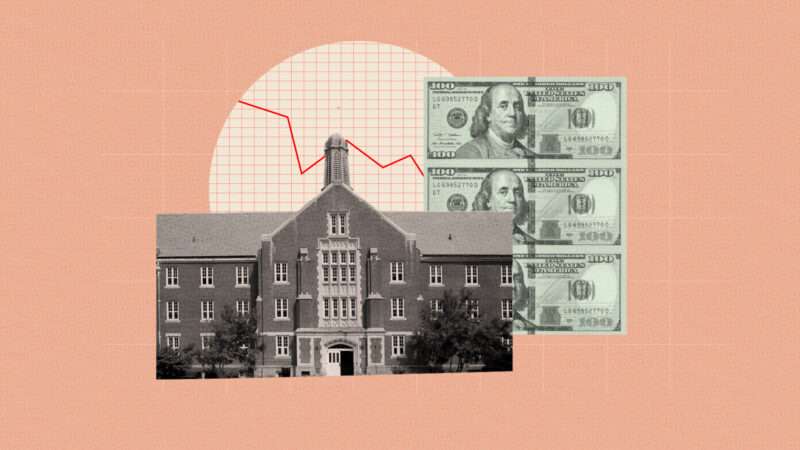
The bursting of the higher education bubble has finally struck its first blow, and it is a serious one. Several major public universities have announced multimillion dollar budget cuts in January, citing enrollment declines among other factors. Pennsylvania State University expects to cut $94 million from its budget starting in July 2025. The University of Connecticut (UConn) announced significant budget cuts in response to its projected $70 million deficit. And the University of New Hampshire (UNH) will slash expenses by $14 million.
These cuts were a long time coming—higher education is facing an enrollment cliff, even as it continues to spend on administration and student services like there’s no tomorrow. Pandemic-era emergency funding could only hold off the reckoning for so long. As university administrators rush to blame their state governments for providing insufficient funds, state legislators should remain staunch in enforcing fiscal discipline on universities. There’s still a long way to go to make higher education cost-effective.
Though university administrators and faculty consider these budget cuts to be nothing short of catastrophic for university operations, some of the cuts appear quite reasonable. For instance, Penn State plans to scale back branch campus operations and cut duplicate programs. This is a necessary step in the right direction—Pennsylvania is known as the “state with too many campuses,” and steep enrollment declines at branch campuses justify reducing their operations.
But even when making the right decisions, universities are too trepidatious. UNH, for example, will cut certain programs at its Aulbani J. Beauregard Center for Equity, Justice, and Freedom. Yet they have not indicated whether only staff or the entire department would be cut. This is not nearly far enough: Not only are diversity, equity, and inclusion (DEI) administrative units like the Beauregard Center unnecessary and expensive, but they are also harmful to the campus environment. DEI initiatives have led universities to monitor what students and faculty say through bias reporting systems and filtered faculty hiring based on race and political views. Budget cuts should not be needed to cut down on these departments—they should never have been created in the first place.
Instead of making further cuts to superfluous administrators, UNH was quick to close its 60-year-old art museum. The museum housed art that faculty regularly incorporated into classes. Some estimate that the art museum operated at just under $1 million annually. The university could have pursued cuts to other departments before going after a key academic institution. Notably, UNH spends more than $1 million on base salaries for DEI staff alone. This estimate is conservative: It excludes benefits, departmental costs, and other roles at the university related to DEI.
UConn’s drastic approach also demonstrates the misguided priorities of higher education leadership. They announced 15 percent cuts across the board, to be doled out equally over the next five years among all units including administration. This approach might seem more “fair,” but it operates on the faulty assumption that waste is concentrated equally among all parts of the university. We know this is not true: report after report has discussed the issues of administrative bloat and extravagant student services. There’s no need to target core educational functions when more low-hanging fruit exists.
These budget cuts have revived the longstanding fights over public subsidies to higher education institutions. Leaders at Penn State and UConn have publicly called out their state legislatures for failing to fund them to their desired amounts. UConn has discussed raising tuition, and Penn State refuses to commit to a tuition freeze even if their funding demands are met. The arguments hark back to debates over state disinvestment in higher education, in which universities claimed that the exorbitant tuition increases over the past several decades had less to do with massive growth in student loan availability and more to do with reductions in state funding.
But the facts simply do not line up with administrators’ narrative. In the case of UConn, the reduction in state funding is not so much a funding cut as it is a return to pre-pandemic realities. Starting in 2020, the Connecticut state government used pandemic relief funds to provide emergency support to its public universities. The relief funds are set to run out in 2025, and the state has not agreed to cover the gap. This makes the current situation an inevitability: pandemic-era relief funds were temporary, but UConn has apparently budgeted as if they were permanent.
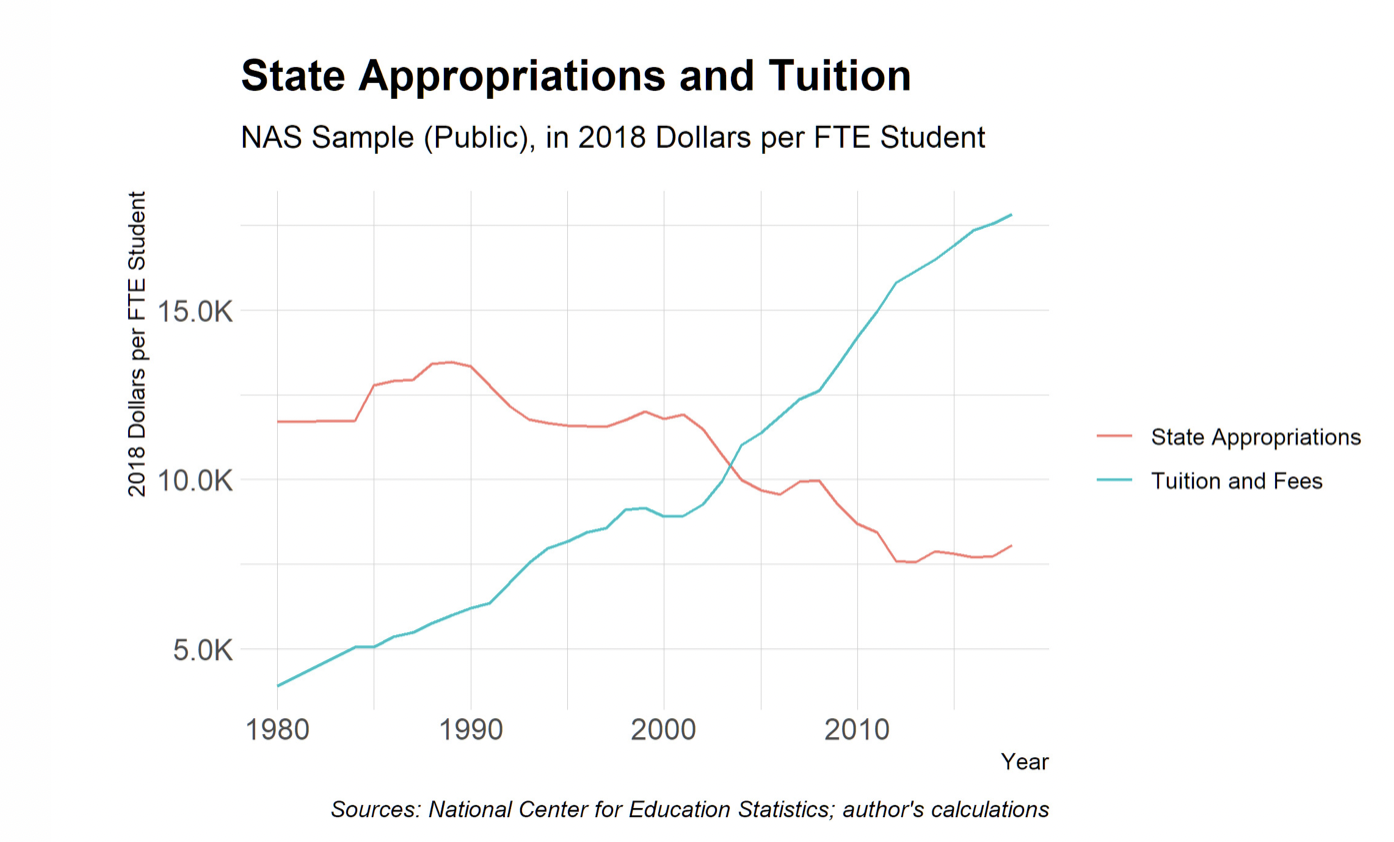
As for increasing tuition, a National Association of Scholars report found that even as state funding per student decreased by nearly $4,000, public universities increased tuition by almost $14,000 per student. State funding decreases alone do not come close to explaining tuition increases. What does explain the increase in tuition is the rapid increase in university expenditures. This is why implementing budget cuts is crucial.
As higher education mourns, taxpayers should welcome budget cuts. Restoring fiscal discipline, though painful in the moment, is the only way to permanently fix our higher education system.
The post University Budget Cuts Were Overdue appeared first on Reason.com.
]]>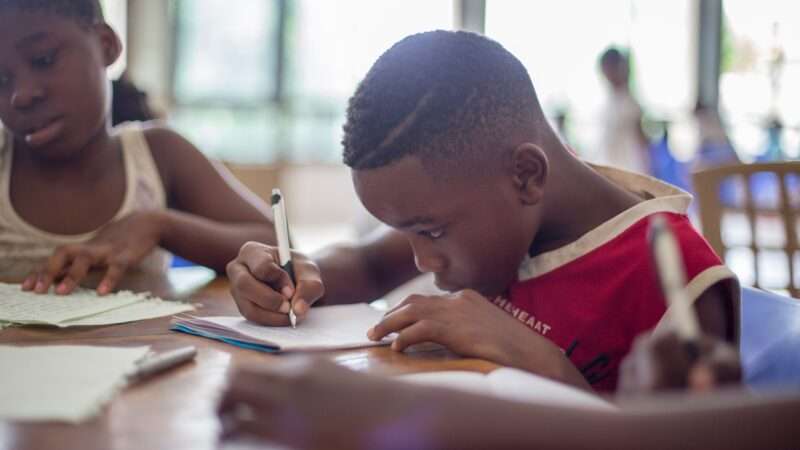
Who benefits from choice in education? The answer, of course, is everybody—at least, everybody can benefit if they’re allowed to choose schooling options that work best for them and their children. That opportunity is perfectly captured by a recent article about black families in Texas who hope to use school vouchers to launch microschools that do a better job than the public school at teaching their children.
When Public Schools Don’t Suit Your Kids
Sneha Dey writes in a Texas Tribune article about a push in that state for school choice:
Here in the eastern suburbs of Dallas, three mothers are home-schooling to reimagine education for their daughters. During school days, the girls get in about two hours of core instruction like reading and math, but they also draw, go on nature walks and build fairy villages with the rocks they find.
The mothers say their public schools were not equipped to create a learning space that’s wholly safe for Black kids or embraces their culture and identity. Together they create lesson plans to meet each girl’s learning needs and adapt their pace when a child is struggling….
The mothers already have spoken with other parents ready to pull their kids out of private and public schools to participate in their collective. But to grow, they say they need the Legislature to create education savings accounts, a voucher-style program through which families could access state funds and pay for private school or alternative education settings.
The model the Dallas mothers want to emulate is that of Arizona’s Black Mothers Forum, whose efforts I covered last year in a piece on microschools. The Black Mothers Forum dedicates itself to “tear down barriers to academic excellence due to low expectations, and break the cycle of the school-to-prison pipeline.” Like the mothers in Dallas, its founders were motivated by doubts about public schools that are common to many families, as well as concerns specific to their experiences as African Americans.
A Surge in Tailored Education Options
As Dey’s piece suggests, microschools span a continuum of education efforts between homeschooling co-ops, private schools, and learning pods. If that sounds a little amorphous, it’s because such arrangements are structured to meet the needs of their participants, not to match institutional definitions. In whatever form they take, microschools are increasingly popular across the United States.
“Currently approximately 125,000 microschools exist across the country, reflecting an increase since the pandemic,” The Wall Street Journal‘s Megan Tagami reported in August. “Across the U.S., microschools likely serve between one to two million students.”
Dey and Tagami both emphasize that growth in microschools and other DIY education approaches is spurred by programs that make education funding portable so that it follows students rather than being dedicated to government-run schools. That’s because many families find it financially difficult to shoulder the costs of education choices on top of the taxes they pay to support public schools they consider inadequate. And no, they wouldn’t be satisfied with increased funding of public institutions—they see that as throwing good money after bad.
“I didn’t just remove my daughter from a building in a school. I removed her from the consciousness that was there that was creating the symptoms of what I was seeing with her in her learning,” Chantel Jones-Bigby, one of the Dallas moms, told the Texas Tribune. “Even if [schools] have more money, if you still have the same culture and consciousness, but new technology, what does that change?”
Funding Students, Not Schools
The usual approach for linking funding to students rather than buildings comes in the form of vouchers, which pay all or part of private school tuition. But flexible education approaches require equally flexible support, which is increasingly provided by Education Savings Accounts (ESA). Adopted so far by 13 states, ESAs put per-student education funding in an account to be drawn down by parents for tuition, homeschooling materials, and other related expenses. In Arizona, ESAs provide 90 percent of the money that would have been spent on each student in public school to be used by families for other approaches. As of this month, over 70,000 students in the state are taking advantage of the program. The Dallas parents want the same opportunity.
“Education savings accounts would allow families to exit the public education system and use taxpayer dollars to pay for alternative learning settings like a microschool,” notes Dey. “The three mothers would welcome those funds to scale up and pay for instructional materials and a dedicated learning space.”
Texas lawmakers are debating whether to add their state to the list of those offering ESAs. Opposition comes not just from Democrats allied with public school teachers unions, but also from rural Republicans who fear diverting resources from traditional district schools. But as the example of the Dallas (and Arizona) moms makes clear, attaching funds to students instead of schools is likely to create more education opportunities as supply increases to meet demand.
A 2022 report from Florida, which offers ESAs, found that “in 2021-22, 16.7 percent of students in Florida’s 30 rural counties attended something other than a district school, whether a private school, charter school, or home education. That’s up from 10.6 percent a decade prior.” According to the report, the number of private schools in rural Florida almost doubled from 69 to 120 between 2001 and 2021.
Public Schools Can’t Serve Everybody
Fueled by ESAs and vouchers, flexible approaches like microschools serve a wide variety of needs and preferences. That’s important at a time when, as The Washington Post recently reported, the ranks of homeschoolers have swelled by 51 percent during a period of declining public school enrollment with participants who are “more racially and ideologically diverse” than in the past. The Dallas moms are part of a wide spectrum of families who aren’t well-served by one-size-fits-some government-run institutions staffed by government-employed teachers using government-developed curricula.
“If there’s been anything that’s been highlighted in a postpandemic world, it’s how necessary being attuned to the individual needs of the student is,” the head of a New York City microschool told The Wall Street Journal.
“As much as I would love the public school system to work for my child, it doesn’t,” Jones-Bigby told the Texas Tribune. “Am I responsible to the system or am I responsible to my child?”
Millions of other American families have faced the same conflict and understandably chosen the needs of their children over sacrificing those needs to keep the system going. Lawmakers who want to help could best do so by getting out of the way of families’ education choices.
The post Black Moms in Texas Want Vouchers for Microschools appeared first on Reason.com.
]]>
A teacher at Sutter Elementary School in Antioch, California, who wasn’t named by the media, has been placed on administrative leave because of her Halloween costume. The teacher came to school wearing a box painted as the Scooby Doo Mystery Machine, her face painted dark to represent the night, and a green moon over her head. Some at the school reportedly found her costume offensive. “We know that there’s a long cultural, historical background to people putting dark makeup on, and there’s a lot of context there that we know is harmful to particular students of color and very particular to the black community,” said school board member Antonio Hernandez. “Regardless of what the intention was, we know what kind of feelings that image can provoke in parents, students and in the community.”
The post Brickbat: Have a Scooby Snack and Chill appeared first on Reason.com.
]]>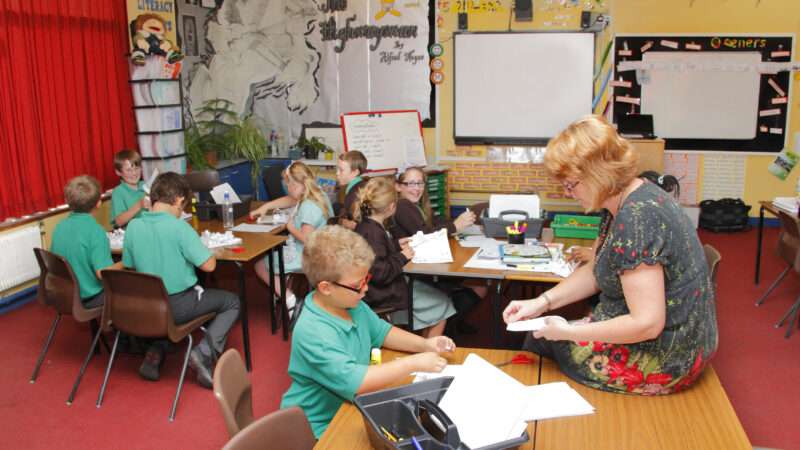
In the United Kingdom, the Labour Party has promised to place a value-added tax on private school tuition if it takes power after the next election, which is scheduled to take place before the end of 2024. The tax is forecast to bring in some £1.7 billion ($2.06 billion) and could raise private school fees up to 20 percent. Labour Party officials said they would use the money to help fund government schools.
The post Brickbat: A Tax on Learning appeared first on Reason.com.
]]>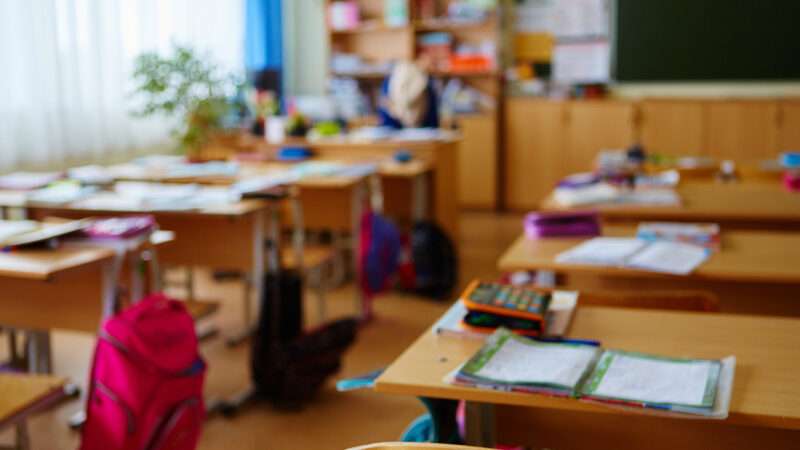
Three and a half years after the onset of the pandemic, enrollment losses are still hampering public schools, who depend largely on student counts to sustain their budgets and pay their staff. Data published in May 2023 by the National Center for Education Statistics (NCES) show that nationwide public school enrollments fell by 3 percent—around 1.4 million students—in the first year of the pandemic and remained at that lower level in the 2021–2022 school year. While national figures for the 2022–2023 school year aren’t available yet, state-level data from California, Illinois, New York, and others show public school rolls still trending downward.
At this point, there’s every indication that the initial public school enrollment shocks from the pandemic won’t rebound any time soon. Educators need to be prepared for a new normal where school choice programs are widespread, families are increasingly choosing options outside of traditional public schools, and public school spending has to be reined in to serve smaller student populations.
Several factors explain why public school student populations are shrinking. Parents were dissatisfied with the prolonged periods of online learning and forced masking at their schools during the pandemic, and the negative effects on students of keeping schools closed have been well-documented. One analysis from the Associated Press found that from 2019 to 2022, “the average student lost more than half a school year of learning in math and nearly a quarter of a school year in reading.” Many of the deep-blue districts that kept schools closed the longest paid the biggest price for that decision, in terms of both enrollment losses and academic backsliding.
Meanwhile, the private education market seems to be booming. According to a study published in February 2022 by the Urban Institute, the pandemic exodus of students from public schools coincided with a sustained increase in private schooling and homeschooling. The 33 states (plus D.C.) with available data saw a more than 4 percent enrollment jump at private schools between fall 2019 and fall 2021—which is unsurprising, given that private schools returned to in-person learning much more quickly than public schools did.
The private education market is also evolving away from traditional classroom formats. The same Urban Institute study found that the 21 states (plus D.C.) with available data saw a more than 30 percent increase in homeschooling in the same timeframe. “Microschools”—tiny private schools that operate in nontraditional settings such as libraries and churches—have also grown substantially. Mike McShane of the pro–school choice group EdChoice told The Wall Street Journal last month that microschools now likely serve between one and two million students.
If public school enrollment isn’t rebounding after the pandemic waned, that’s a sign that families are largely sticking with these new learning settings. This momentum will likely continue thanks to the flurry of school choice programs that were either adopted or expanded in the 2021, 2022, and 2023 state legislative sessions.
There is another critical piece behind the decline in public school enrollment that shouldn’t be overlooked. NCES projections of stagnating and declining school-age populations in many of the nation’s large and coastal states actually predate both the pandemic and the recent surge of school choice. These two factors seem to have accelerated population changes that many school systems were going to soon confront anyway.
Unfortunately, public school systems have a poor track record of reining in spending and staffing when student populations decline. States that already had declining enrollment before the pandemic—places like California, Illinois, Michigan, New York, Pennsylvania, and Massachusetts—have invariably kept hiring more staff rather than making reductions and are spending at record-high rates per student.
Even now, public schools are refusing to deal with the financial effects of their pandemic-era student losses. Rather than using strong state tax revenues and billions of federal stimulus dollars to gently pare down budgets, some of the biggest enrollment losers, such as New York City Public Schools and Los Angeles Unified School District, have used their funds to stave off budget cuts altogether.
Those extra federal funds will be drying up soon, and public schools will soon face reality. Between the pandemic, school choice, and long-term population shifts, they will finally have to exercise some fiscal restraint.
The post Public Schools Must Face the Reality of Shrinking Enrollment appeared first on Reason.com.
]]>